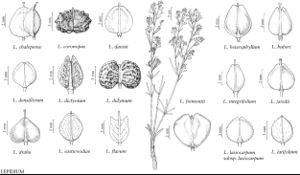Lepidium fremontii
Botany (Fortieth Parallel), 30, plate 4, figs. 3, 4. 1871.
Perennials or subshrubs; (woody base aboveground); (glaucous), glabrous throughout. Stems several from base, erect or ascending, branched (several) distally, 2–5.5 (–10) dm. Basal leaves absent. Cauline leaves sessile; blade linear and undivided or pinnately lobed (lobes 3–7 (–9), linear), (1.5–) 2.2–8.4 (–10.2) cm × (0.7–) 1–2.8 (–4.2) mm, base attenuate, not auriculate, margins entire, (similar, smaller distally). Racemes (panicles), elongated in fruit. Fruiting pedicels divaricate-ascending to horizontal, usually straight, rarely slightly curved, (terete), (3.5–) 4.3–7.6 (–8.5) × 0.15–0.2 mm. Flowers: sepals obovate, 1.5–2.5 (–3) × 1–1.6 mm; petals white, spatulate, 2.5–4.2 × 1.5–2.2 mm, claw 1–2 mm; stamens 6; filaments 1.8–3 mm; anthers 0.4–0.7 mm. Fruits obovate to orbicular, (4–) 4.5–7 (–8) × 4.2–7 (–8) mm, apically winged, apical notch (0.1–) 0.2–0.5 mm deep; valves thin, smooth, not veined; style 0.2–0.8 (–1) mm, exserted beyond apical notch. Seeds ovate, 1.6–2.1 × 0.9–1.1 mm. 2n = 32.
Phenology: Flowering Mar–Jun.
Habitat: Desert shrub communities, pinyon-juniper woodlands, sandy washes, gravelly deserts, barren knolls, bluffs, roadsides, steep limestone outcrops, rocky ledges and slopes
Elevation: 400-2100 m
Distribution

Ariz., Calif., Nev., Utah.
Discussion
Rollins established var. stipitatum on the basis of fruits obovate with gynophores 0.5–0.75 mm versus (var. fremontii) fruits orbicular to ovate and sessile. These two characters often do not covary and stipitate fruits occur sporadically throughout the species range, including Arizona (Lemmon s.n., GH), California (Morefield 3427, GH), and Nevada (Comanor 18, GH; Hitchcock 3078, GH).
Selected References
None.
Lower Taxa
"elongated" is not a number."thick" is not a number."dm" is not declared as a valid unit of measurement for this property."dm" is not declared as a valid unit of measurement for this property.
